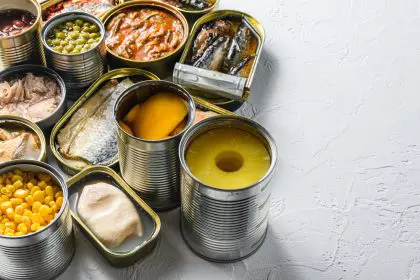That fresh spinach you’re adding to your smoothie could be harboring microscopic parasites that are about to take up residence in your digestive system. While you’re focusing on organic labels and nutritional content, potentially thousands of parasite eggs and cysts are hiding on surfaces and within the cellular structure of foods you consider healthy and safe.
Parasites in food aren’t just a problem in developing countries or exotic cuisines, they’re present in everyday foods sold in developed nations, including items from upscale grocery stores and health food markets. The globalized food supply chain has created opportunities for parasites to travel across continents, ending up on dinner plates in countries where people assume their food supply is completely safe.
What makes this particularly concerning is how many parasite infections remain undiagnosed for months or years, causing mysterious health problems that get attributed to stress, aging, or other conditions while the real culprits continue reproducing and causing damage throughout your body.
Why modern food systems are parasite highways
The global food supply chain creates multiple contamination opportunities as produce travels through different climates, water systems, and handling facilities before reaching your plate. Each step in this journey represents a potential exposure point where parasites can contaminate otherwise clean food.
Industrial farming practices that rely on contaminated water sources for irrigation can introduce parasites directly into the growing process, allowing them to become embedded in plant tissues where surface washing can’t remove them. This internal contamination makes even thoroughly cleaned produce potentially dangerous.
The use of untreated human waste as fertilizer in some agricultural regions creates ideal conditions for parasite transmission through the food chain. These practices, while economically driven, can contaminate soil and water systems for years, affecting multiple growing seasons.
Processing facilities that handle massive volumes of food from diverse sources can cross-contaminate clean products with parasite-laden ones through shared equipment, water systems, and handling procedures that aren’t designed to prevent microscopic contamination.
The common foods that harbor dangerous hitchhikers
Fresh leafy greens, particularly those eaten raw like lettuce, spinach, and herbs, are among the highest-risk foods for parasite transmission because they’re often irrigated with contaminated water and consumed without cooking that would kill parasites. The complex leaf structures provide perfect hiding places for parasite cysts.
Berries and soft fruits can harbor parasites both on their surfaces and within their cellular structure, particularly when grown in regions with poor water quality or sanitation practices. The porous nature of berry skin makes it difficult to remove all contamination through washing alone.
Sprouts and microgreens grown in warm, moist conditions provide ideal environments for parasite development and can become heavily contaminated during the growing process. These foods are particularly dangerous because they’re often consumed raw and in large quantities by health-conscious individuals.
Fresh herbs, especially those grown in developing countries, frequently test positive for various parasite species because they’re often grown using contaminated water and consumed fresh without cooking. Cilantro, parsley, and basil are among the most commonly contaminated herbs.
The water connection that most people ignore
Washing produce with contaminated tap water can actually increase parasite contamination rather than reducing it. Many municipal water systems contain low levels of parasites that aren’t removed by standard treatment processes, and these can adhere to food surfaces during washing.
Ice used in restaurants and food service establishments may be made from contaminated water sources, introducing parasites into drinks and food preparations that would otherwise be safe. The freezing process doesn’t kill all parasite species, and some actually survive freezing better than other conditions.
Imported bottled water used for food preparation may come from sources with different safety standards and could introduce parasites that aren’t commonly found in local water supplies. The lack of standardized international testing creates gaps in safety protocols.
Even seemingly clean water sources can become contaminated during distribution through aging infrastructure, cross-connections, or contamination events that aren’t immediately detected by monitoring systems.
How parasites survive your kitchen defenses
Many parasite cysts are resistant to standard disinfectants and sanitizers used in food preparation, including bleach solutions and commercial produce washes. Some species actually require exposure to harsh chemicals to complete their life cycles, making conventional cleaning methods ineffective.
Refrigeration doesn’t kill most food-borne parasites and may actually help preserve them until they reach more favorable conditions in your digestive system. The cold temperatures slow their metabolism but don’t eliminate the threat they pose.
Surface washing removes only parasites that aren’t firmly attached or embedded in food tissues. Many species have specialized attachment mechanisms or can penetrate into plant tissues where they’re protected from external cleaning efforts.
Some parasites can survive cooking temperatures that would kill bacteria and viruses, particularly when food isn’t heated evenly or for sufficient duration. The internal temperatures needed to kill certain parasite species exceed those commonly achieved in home cooking.
The symptoms that might actually be parasite infections
Chronic digestive issues like bloating, gas, alternating constipation and diarrhea often get attributed to stress or dietary intolerances when they might actually indicate parasite infections. These symptoms can persist for months or years while the underlying infection goes undiagnosed.
Unexplained fatigue and energy crashes that don’t improve with rest or dietary changes could result from parasites competing with your body for nutrients or producing toxic metabolites that interfere with normal energy production.
Skin problems including unexplained rashes, itching, or inflammatory conditions might be your immune system’s response to parasite infections rather than allergies or dermatological conditions. Some parasites can migrate through skin tissues, causing localized reactions.
Mental fog, mood changes, and cognitive problems can result from parasite-produced neurotoxins or inflammatory responses that affect brain function. These neurological symptoms often develop gradually and may not be connected to the original infection.
The testing gap that leaves infections undetected
Standard medical testing often misses parasite infections because many species are difficult to detect through conventional stool samples. Single stool tests may miss infections that are present but not actively shedding detectable levels of eggs or cysts.
The timing of testing relative to parasite life cycles can affect detection rates, as many species only release detectable materials during specific phases of their reproduction. This intermittent shedding makes diagnosis challenging even when infections are present.
Many healthcare providers don’t consider parasite infections in patients from developed countries, leading to delayed or missed diagnoses when symptoms could indicate parasitic disease. The assumption that parasites are primarily tropical diseases can prevent appropriate testing.
Specialized testing methods that can detect a broader range of parasite species are available but aren’t routinely used in standard medical practice. These advanced tests might reveal infections that conventional testing methods miss entirely.
The immune system impact that compounds health problems
Chronic parasite infections can suppress immune system function, making you more susceptible to other infections, autoimmune conditions, and allergic reactions. The constant immune activation required to fight parasites can exhaust your body’s defensive capabilities.
Some parasites actively manipulate immune responses to ensure their survival, creating immune dysfunction that persists even after the infection is eliminated. This manipulation can contribute to the development of autoimmune diseases and chronic inflammatory conditions.
The inflammatory response to parasite infections can damage tissues throughout your body, contributing to chronic pain, joint problems, and organ dysfunction that might not be immediately connected to the original infection.
Nutritional deficiencies can develop when parasites compete with your body for essential nutrients or damage the intestinal lining’s ability to absorb nutrients properly. These deficiencies can cause widespread health problems that seem unrelated to digestive issues.
The prevention strategies that actually work
Proper food preparation techniques that go beyond standard washing can significantly reduce parasite exposure risk. This includes using filtered or bottled water for washing produce, particularly for foods that will be consumed raw.
Freezing certain foods for specific durations can kill parasite species that survive other preservation methods. However, this approach requires understanding which parasites are susceptible to freezing and the temperatures and durations needed for effective elimination.
Avoiding high-risk foods during travel or when eating at establishments with questionable food safety practices can prevent exposure to parasite species that aren’t commonly found in your local food supply.
Supporting your immune system through proper nutrition, adequate sleep, and stress management helps your body defend against parasite infections and recover more quickly if exposure occurs.
The testing and treatment options available
Comprehensive parasite testing using advanced laboratory methods can detect infections that standard testing misses. These tests may include DNA-based detection methods, antigen testing, and examination of multiple sample types.
Natural anti-parasitic protocols using herbs and supplements can be effective for certain parasite species, particularly when combined with dietary modifications that create hostile environments for parasite survival.
Prescription anti-parasitic medications are available for diagnosed infections, but their effectiveness varies depending on the specific parasite species and the extent of infection. Some infections may require multiple treatment courses.
Follow-up testing after treatment is important because some parasite species are difficult to eliminate completely and may require repeated treatment cycles to achieve full clearance.
The dietary modifications that create hostile environments
Certain foods and dietary patterns can make your digestive system less hospitable to parasites while supporting your immune system’s ability to fight infections. These modifications work by changing pH levels, introducing anti-parasitic compounds, and supporting beneficial gut bacteria.
Eliminating sugar and refined carbohydrates can starve certain parasite species that depend on these nutrients for survival and reproduction. This dietary change can be particularly effective when combined with other anti-parasitic strategies.
Including foods with natural anti-parasitic properties like garlic, pumpkin seeds, and certain herbs can help prevent infections and support treatment efforts. These foods contain compounds that are toxic to many parasite species.
Supporting gut health through probiotics and fermented foods helps maintain beneficial bacteria populations that compete with parasites for resources and create environments that discourage parasite establishment.
The reality check about food safety
No food supply is completely free from parasite contamination risk, and assuming that expensive or organic foods are automatically safe can lead to dangerous exposure. Vigilance and proper food handling are necessary regardless of food source or price point.
The symptoms of parasite infections can be subtle and develop gradually, making it easy to attribute them to other causes while the infection becomes established and potentially spreads to other family members.
Regular parasite testing might be appropriate for people with unexplained health issues, particularly those with digestive problems, fatigue, or immune system dysfunction that doesn’t respond to conventional treatment approaches.
Your kitchen as a parasite prevention zone
Understanding the real risks of parasite contamination in common foods empowers you to take appropriate precautions without becoming paralyzed by fear. Simple changes in food handling and preparation can dramatically reduce your exposure risk while still allowing you to enjoy a varied, nutritious diet.
The key is balancing awareness of parasite risks with practical prevention strategies that fit into your lifestyle. You don’t need to avoid all fresh foods, but you do need to handle them with the understanding that invisible threats might be present.
Taking parasite prevention seriously as part of your overall health strategy can prevent infections that might otherwise cause months or years of unexplained health problems. Your vigilance in the kitchen today could save you significant health challenges tomorrow.

















